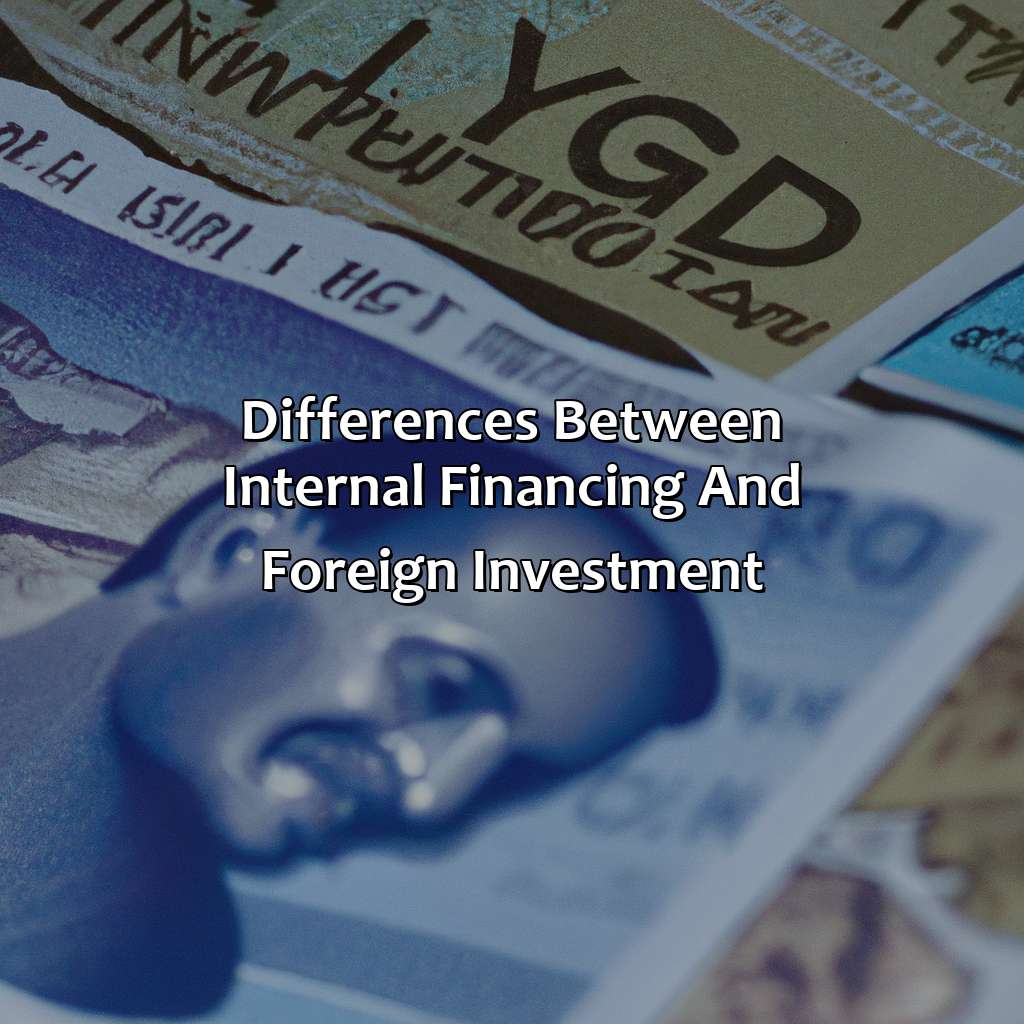How Do Internal Financing And Foreign Investment Differ?
Key Takeaways:
- Internal financing refers to raising capital from within a company, while foreign investment involves obtaining funding from outside the company, often from foreign sources.
- Internal financing can provide greater control over the company’s finances, but may be limited by the availability of funds. Foreign investment can provide access to a larger pool of capital, but may result in a loss of control and increased risk.
- Factors to consider when choosing between internal financing and foreign investment include the availability of funds, risk tolerance, and company objectives and strategy.
In today’s increasingly globalized economy, businesses need to understand the differences between internal financing and foreign investment. You want to make sure you’re choosing the right option for your business; ours is a comprehensive guide to help you do just that.
Overview of Internal Financing and Foreign Investment
Internal Financing vs Foreign Investment: What Sets Them Apart?
Internal financing and foreign investment are two distinct methods of funding an enterprise. The former denotes the resources generated by a company from its retained earnings, while the latter refers to external funds coming from foreign entities. The primary difference between the two lies in the origin of funds.
An organization’s internal financing comes from its own net income, whereas foreign investment originates from various sources outside the business. Moreover, internal financing is a self-sustaining approach that relies on the company’s operational profits, while foreign investment requires cooperation with external investors or entities.
It’s worth noting that while both financing methods have their own merits, foreign investment can be an excellent means of acquiring additional resources that can help support a firm’s expansion. However, given the external nature of foreign investment, there’s an increased dependency on the investors or entities involved.
Pro Tip: Companies should consider weighing the pros and cons of both financing methods and create a balanced approach that caters to their specific financial requirements.

Image credits: retiregenz.com by David Arnold
Differences between Internal Financing and Foreign Investment
Internal financing and foreign investment are two distinct methods of obtaining funding for a business operation. Internal financing is the process of generating funds from within a company, while foreign investment refers to receiving capital inflow from sources outside of the country.
A comparison between Internal Financing and Foreign Investment is given below in the form of a table.
| Criteria | Internal Financing | Foreign Investment |
|---|---|---|
| Ownership | 100% owned by the company | Shared ownership |
| Interest rate | Relatively low | Relatively high |
| Repayment Period | Flexible | Strict |
| Political Risk | Not affected | Affected |
| Control | Maintained by existing management | Shared control |
| Tax | No withholding tax | Subject to withholding tax |
| Currency Risk | No exchange rate risk | Exposed to currency fluctuations |
It should be noted that foreign investment carries additional risks, such as political instability and currency fluctuations. On the other hand, internal financing provides greater control and flexibility to the company, but may not provide enough capital required for growth.
Pro Tip: Companies may use a combination of internal financing and foreign investment to optimize their funding strategy, taking advantage of their benefits and minimizing their potential drawbacks.

Image credits: retiregenz.com by Joel Jones
Advantages and Disadvantages of Internal Financing and Foreign Investment
Internal financing and foreign investment are two significant approaches to raising funds for business growth. Each option presents its advantages and disadvantages.
-
Internal Financing:
-
Pros:
- Retain Control: Internal financing enables the business owner to retain full control of the company and avoid sharing decision-making power with external investors.
- No Interest Payment: Internal financing eliminates the need to pay interest on borrowed funds. Hence, it results in higher retained earnings and profitability.
- Faster Decision-Making: Internal financing involves less paperwork, approval processes, and complexities than seeking external financing. Hence, it allows for quicker decision-making.
-
Cons:
- Limited Funds: Internal financing may not offer access to significant capital required for big expansion projects and may cause managers to miss out on promising investment opportunities.
- No Diversification: Internal financing can result in a lack of diversification in investment portfolios. It can mean that the business owner is too heavily invested in one business, which may increase risk.
- Stagnation: By relying solely on internal financing, managers may become complacent about pursuing external financing and may miss out on market opportunities.
-
Pros:
-
Foreign Investment:
-
Pros:
- Access to Capital: Foreign investment can provide businesses with access to significant capital that may not have been available through internal financing or domestic investment.
- New Market Entry: Foreign investment can help businesses enter new markets, gain exposure to new customers, and diversify their customer base.
- Technology Transfer: Through foreign investment, businesses may have access to new technology, ideas, and expertise that can help drive innovation.
-
Cons:
- Loss of Control: Foreign investment may dilute the business owner’s equity stake and control over decision making, which can lead to potential conflicts of interest and loss of independence.
- Political Risk: Investing in foreign countries may expose businesses to political instability, legal challenges, and currency fluctuations, increasing operational risk.
- Higher Cost: Foreign investment may bring higher costs due to legal fees, translation, and other expenses associated with conducting business in a foreign country.
-
Pros:
It’s important to note that while both internal financing and foreign investment can help businesses grow, they each come with unique advantages and disadvantages depending on the specific business’s needs and goals.
Additionally, a World Investment Report by the United Nations Conference on Trade and Development (UNCTAD) in 2020 revealed that foreign direct investment (FDI) flows fell by 42% due to the COVID-19 pandemic’s impact on investment sentiments.

Image credits: retiregenz.com by James Arnold
Factors to Consider when Choosing between Internal Financing and Foreign Investment
In deciding how to raise capital for a business, one must evaluate the advantages and disadvantages of both internal financing and foreign investment. Factors to consider include the level of control desired, the cost of capital, the risk involved, and the timing of the investment. It is important to carefully analyze each option to determine which is the best fit for the unique needs of the business.
Internal financing offers the advantage of maintaining complete control of the business and avoiding the potential cultural and legal issues that may arise with foreign investment. However, it may limit the ability to expand quickly and require a longer period of time to accumulate sufficient funds. Foreign investment, on the other hand, can provide significant capital injections and access to new markets, but may come with a loss of control and cultural challenges.
Another important factor to consider is the cost of capital, which can vary significantly between the two options. Internal financing generally requires a lower cost of capital since the business is not required to pay interest or dividends to external investors. In contrast, foreign investment often comes with higher interest rates, management fees, and other expenses.
Pro Tip: Before making a decision, it is wise to seek advice from professionals with experience in both internal financing and foreign investment. By considering all options and making an informed decision, a business can set itself up for success and long-term growth.

Image credits: retiregenz.com by Yuval Arnold
5 Facts About How Do Internal Financing and Foreign Investment Differ:
- ✅ Internal financing is the use of a company’s profits to fund its business activities, while foreign investment is the investment of funds from outside the country. (Source: Investopedia)
- ✅ Internal financing is a more dependable source of funding, while foreign investment is subject to changes in political, economic, and social factors. (Source: Wall Street Mojo)
- ✅ Internal financing does not involve the involvement of outside parties, while foreign investment often requires collaboration with international partners. (Source: The Balance Small Business)
- ✅ Internal financing provides companies with more control over their business decisions, while foreign investment may come with stipulations and restrictions from foreign investors. (Source: Business Jargons)
- ✅ Internal financing has lower transaction costs and avoids currency exchange risks, while foreign investment involves higher transaction fees and risks related to fluctuations in the exchange rates. (Source: Toppr)
FAQs about How Do Internal Financing And Foreign Investment Differ?
How do internal financing and foreign investment differ?
Internal financing refers to the funding of a company’s activities using its own resources, such as profits or retained earnings, while foreign investment involves the injection of capital from investors or businesses located outside the company’s home country.
What are the advantages of internal financing?
Internal financing can be advantageous because it does not involve borrowing money, which can lead to debt and interest payments. It also gives companies more control over their financial decisions and can help them to build up reserves for future investments.
What are the advantages of foreign investment?
Foreign investment can provide a source of capital that may be difficult to obtain domestically, particularly for small businesses. It can also provide access to new markets, resources, and expertise, which can help businesses to expand and innovate.
What are the risks associated with internal financing?
The primary risk associated with internal financing is that companies may not have enough funds to invest in their own growth, which can lead to missed opportunities and lost revenue. Additionally, relying solely on internal financing can limit a company’s ability to compete with larger, more well-funded competitors.
What are the risks associated with foreign investment?
Foreign investment can be risky because it involves a loss of control over a company’s financial decisions and operations. It can also be subject to legal and regulatory challenges, as well as fluctuations in exchange rates and political instability.
How can companies choose between internal financing and foreign investment?
Companies must carefully evaluate their financial needs, growth potential, and risk tolerance to determine whether internal financing or foreign investment is the better option. In many cases, a mix of both may be the most effective approach, allowing companies to balance control, risk, and access to capital.
